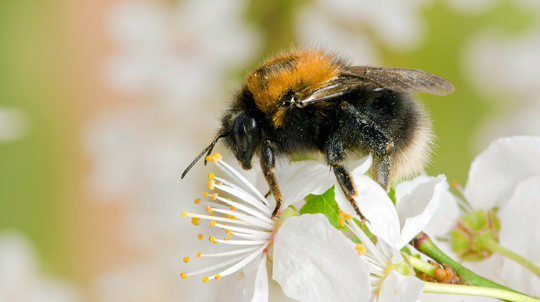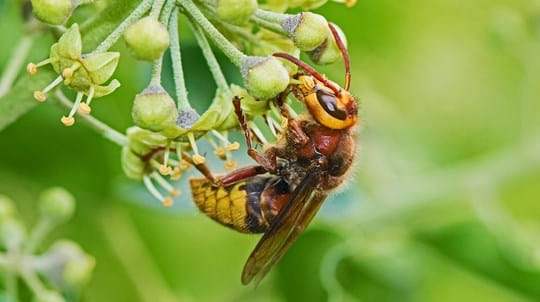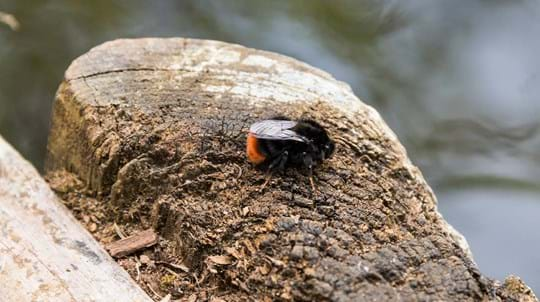Identify minibeasts
Explore woodland creepy crawlies, from bugs and beetles to snails and spiders, with a pocket-sized swatch book.
Buy it now
Digital Content Manager
Have you ever seen a giant wasp when out working in the garden or visiting the woods? If so, it's likely you'll have spotted a queen wasp: the leader of the colony, a skilful builder and an egg-laying machine.
The queen wasp is the architect of a wasp colony – a tough cookie who builds the initial nest structure, lays thousands of eggs and even hibernates through the cruel winter, ready to start a new colony the following year.
The queen wasp is very similar in appearance to the workers. She has bright yellow and black stripes, a triangle-shaped head and a distinctive ‘waist’. In terms of size, however, she is much larger. Queens usually measure around 2cm in length, whereas workers measure approximately 1.2–1.7cm.
Explore woodland creepy crawlies, from bugs and beetles to snails and spiders, with a pocket-sized swatch book.
Buy it nowMale wasps (known as drones) don’t have a sting.
Just like her workers, the queen wasp has a sharp sting which she’ll use when she feels threatened. The sting is a modified ovipositor (egg-laying tube) which has evolved a piercing tip. She still lays eggs using her ovipositor – just through a different opening.
The best time to see a queen wasp is at the beginning of spring or the end of summer. This is because the queen emerges from hibernation at the start of spring in search of the perfect place to build her nest, and then later, at the end of summer, the new queens leave their nest to mate.
Queen wasps can be seen in parks, gardens, woods and meadows. During spring you might see them building nests in woodland, and during the colder months they will venture to sheltered areas to hibernate – maybe even your garden shed!
A wasp nest can contain 5,000–10,000 individuals.
Queen wasps go into hibernation in winter – but they aren’t the same queens who established the nest in spring. The original wasp queen dies at the end of summer, while the new queens that hatched from her nest leave the colony to mate, before finding a safe place to sleep through the winter. It's a dangerous time for these new queens, with many eaten by spiders before they have a chance to emerge and start a colony of their own. Those that do survive emerge around February.
Once the queen has chosen a suitable place to build her nest – such as a hollow tree or an old mammal hole – she starts the construction process using 'paper' which she creates by chewing up wood. She builds a central column (known as a petiole), which she covers in a chemical that repels ants. She then forms 20–30 cells around this column and lays an egg in each.
Once the eggs have hatched, the queen wasp divides her time between feeding her larvae and building the nest, until the young develop into adult wasps. These usually emerge from early June and are sterile, female workers who take over nest building, foraging and feeding duties while the queen spends the rest of her life laying eggs.
By September, new queen wasps and male wasps (drones) emerge from the nest to mate, marking the end of the nest’s cycle. The old queen will die – as will the males after mating – and the new queens will overwinter in holes or other sheltered locations, ready for the cycle to begin again the following spring.
Nature’s Calendar helps us track the effects of climate change on wildlife across the UK. By adding your own records, you can help us see whether queen wasps are emerging earlier or later than usual, along with the changing climate.

Have you seen your first butterfly or swallow of spring? Or your first ripening berry or autumn leaf tint? Let us know what's happening to animals and plants near you and help scientists track the effects of climate change on wildlife.
Join Nature's Calendar
Trees woods and wildlife
Bees, wasps and ants all form part of the insect order Hymenoptera, a large and diverse group made up of 'membrane-winged' insects. Find out more.

Trees woods and wildlife
The king of the wasps with a fearsome reputation, the hornet is actually much less aggressive than its smaller cousin, the common wasp.

Blog
Charlotte Varela • 18 Nov 2022